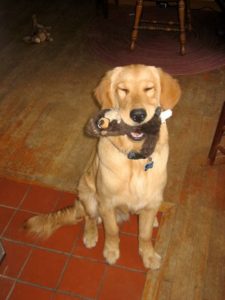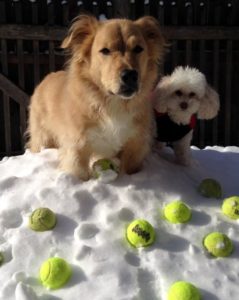As often occurs in science, once scientists started looking for tool use in nonhuman animal species, they found members of multiple species throughout the animal kingdom exhibiting this behavior in nature. (See this Wikipedia article for a nice overview of this subject.) Historically, tool use was considered one of those skills that made humans superior. Then when evidence of it appeared in wild animals, some said those animals must have learned it from humans. But then evidence ruled that out too.
Naturally, this got me thinking about tool use in dogs and cats and whether the lack of reports of this say more about our attitudes toward these species than the animals themselves. Is it possible that we’ve become so conditioned to dogs and (to a lesser degree) cats doing all kinds of clever things because we trained them to do these that the idea that they could come up with their own clever forms of tool use never crosses our minds?
Consider Sterling,a dingo who resides at Dingo Discovery and Research Facility in Melbourne, Australia. Researchers couldn’t explain why the metal tag on the enclosure he shared with two other dingoes kept disappearing because it was located too high for the animals to reach. To solve this mystery, they first tried attaching a packet of food beside the tag and observing the dingoes. When the dingoes ignored the food and the tag when observed, the researchers set up a video system using the food bait and discovered this:
This study fascinated me because I wondered why they didn’t just set up the video experiment sans food to determine what happened to the tag? Why would they replace the tag with food? Does scientific protocol insist that only food can be used in animal intelligence studies? Or have researchers become so accustomed to using food to lure animals to do something that they couldn’t imagine doing anything else?
Such as what, you may be thinking. Personally, I found the idea that Sterling would remove the tags far more interesting than his eating the food, especially because the name tags had vanished. Unfortunately, the experiment reveals nothing about this potentially much more intriguing behavior.
Could similar bias blind us to tool use in dogs and cats? It’s possible. Consider the case of Elizabeth, a very intelligent Australian shepherd of strong working dog breeding. Once her people refocused her on a roster of acceptable farm chores instead of protecting them, she became a model canine companion and farm dog. However, two tool use examples related to her demonstrate the disconnect that may occur when we think about this concept in dogs. One involved a thorny thicket that sheltered a wild rabbit and her brood that attracted Elizabeth several times a day. According to her owner, you could see the wheels spinning in her dog-head as she approached the thicket from all sides at a different time during her daily cycle, presumably in hopes of finding an entry point. One day when the owner relaxed outdoors watching the sunset, Elizabeth marched purposefully toward the thicket carrying a long stick.
The thought that immediately popped into the woman’s head was, “Oh, no! She’s learned to use tools!”
In this case, the owner immediately made the connection between sticks and tool use based on her knowledge of studies in a variety of primates and birds who use sticks to lure or drag food items or prey closer to them. But although she made that connection immediately, she hadn’t noticed how Elizabeth had learned to use the zoomies to control human activity when she and her husband people entertained guests outdoors.
For those unfamiliar with the term, zoomies involve running in circles at full speed. The most common context in which the behavior appears in puppies and young animals celebrates that all is well. As in, “My physical and mental space is secure, so I can use all my energy to run around like crazy.” But dogs of all ages may use the zoomies to communicate the exact opposite, that they feel stressed and vulnerable and no other alternative exists to dissipate these feelings. For example and perhaps because of her strong working dog roots, in her past Elizabeth used zoomies as as a way to corral her otherwise wandering human herd to make protecting them easier. She used this behavior the same way a person would use a fence or even a prod.
This brings up what I consider a valid ethological point when it comes to tool use in companion dogs and cats. Because they often live in highly controlled environments, they may need to adapt existing behaviors and objects to meet new needs.
Another behavioral adaptation does involve a tool, in this case a bell. Sometimes people will attach a ribbon with a bell on the end of it to the knob of an exterior door as part of their canine house-training protocol. The idea is that the dog will associate the sound of the bell with going outside to pee or poop. Theoretically, this spares the owner all the work associated with regulating the puppy’s access to food and water and establishing a schedule of outings instead. When the bell rings, they would know the puppy needs to pee or poop and take the puppy out.
Or so the thinking goes. But over time, a fair number of dogs assign a new function to this human tool. Instead of ringing the bell when they need to relieve themselves, they start ringing it when they want the owner to open the door for some other reason. Perhaps the dog wants to go outside to pinpoint the source of a scent or sound he detected out there. Or maybe she’s bored. Sort of like the way Lord or Lady Snodgrass would ring a bell to summon the butler or maid to attend their needs.
Once outside, some of these dogs will show no interest in peeing or pooping, and focus instead solely on their real reason for being out there. When they do this repeatedly, eventually most folks figure out they’re being conned and the bell disappears. However, some people are so afraid that the dog might pee or poop in the house that they keep opening the door every time the dog rings the bell. Although the dog’s behavior superficially remains the same, the dog’s motivation for displaying it is entirely different. Some dogs may keep the deception going by straining to summon a few drops or urine or dollops of poo to reward the overly anxious door-keeper. This may result in multiple trips to the veterinary clinic for possible urinary or GI tract problems unless the behavioral/bond context is added to the history and work-up.
Dogs also may use leashes as behavioral tools to control human behavior. Companion dogs in protective mode ambivalent to or overwhelmed by their role may shove balls or tug-toys at people to lure them into games of fetch or tug until a perceived threat goes away. As long as the game goes on, the person remains fully focused on the dog. This makes that person much easier for the dog to protect. One signal of such displays is that the dog will suddenly abort the “play” and go do something else when the threat passes. Unfortunately, because many of these triggers maybe stimuli beyond human perception and people often only recognize these behaviors as celebratory play displays, some folks may perceive the dog’s termination of the interaction as rejection.
Cats also may engage in episodes of behaviors that we perceive as playful in one context and maddening in another. It’s a fun game if Fluff retrieves her stuffed mice when Don tosses them in their evening play sessions. However, it’s not fun when the cat drops those same toy mice on her sleeping owner and plays hockey with them on his chest to dissipate stress associated with free-roaming feline or other animals’ activity outdoors.
While people might teach their cats to pee and poop in toilets, I’ve yet to encounter a person who taught their fresh-water-loving cat to turn on the faucet to ensure a steady supply of it. Even though there’s so shortage of cats that do this.
Then there’s this cat who found a novel use for a deck rug:
Cats and dogs also will use a variety of bags, boxes, handbags, sleeping bags, backpacks, briefcases and other items as beds, and all kinds of furnishings–including curtain rods–designed for other purposes as observations posts. And finally, we have all those dogs and cats who use toys, blankets, pillows, rugs, their owners’ clothing, or other household objects as pacifiers. Some animals will suck on softer objects such as stuffed toys or blankets when stressed whereas  others will rip them to shreds. As they become sexually mature, and regardless whether they’re spayed or neutered, they may masturbate using those same objects to achieve this same goal.
others will rip them to shreds. As they become sexually mature, and regardless whether they’re spayed or neutered, they may masturbate using those same objects to achieve this same goal.
Unfortunately, some of the objects dogs in particular press into service as pacifiers because they carry their owner’s scent can cause them serious (and expensive) medical problems. These include shoes, underwear, remote control devices, knives, pens and pencils, handbags, backpacks, babies’ pacifiers, and kids’ toys of all kinds. Bored cats may knock plastic vials of prescription medication off counters or shelves onto the floor and play with them. At best, their owners may wind up searching their homes on their aching hands and knees looking for their pain-killers. At worst, hard to open child-proof lids may not be secured and the cat or other household pets eat the medication with dire consequences. Cats also may take jewelry or paper currency and hide it. One cat made “scent trail” by lining up her owner’s socks.
If the human response in these situations is limited to removing all such objects instead of relieving any stress, the next tool the animal invents to do that may be worse. Although superficially a rock may seem cheaper than a diamond engagement ring, the cost to the animal and the owner to remove a stomach full of rocks from a dog may be much more than the removal of the much smaller ring.
Although none of these objects may rank as tools in the sense of sticks used by wild animals to lure termites out of their nests or the saws or hammers used by human carpenters, they all have one thing in common: They all function as a way to solve a problem that otherwise would be unsolvable. Whereas the problem for wild or free-roaming domestic dogs and cats may be ensuring their food supply or escaping predators, that of companion dogs and cats may be ensuring their mental and emotional health. By keeping this in mind, we can better appreciate their intelligence and ingenuity, and help them when their chosen toys and behavior tell us they’re stressed.

No question my cat used a tool one day. She held an unplugged electric cord close to the plug between her front paws and used the plug end to scratch her head where she often liked it when I scratched her there!
My dog pushed a coffee table up against a fireplace and stood on it on his hind legs to knock stuff off the mantel — including what he thought was some chocolate (he LOVED chocolate). He then learned hat his “pride” was a chocolate scented candle I’d received as a gift. He only bit the candle a couple of times.